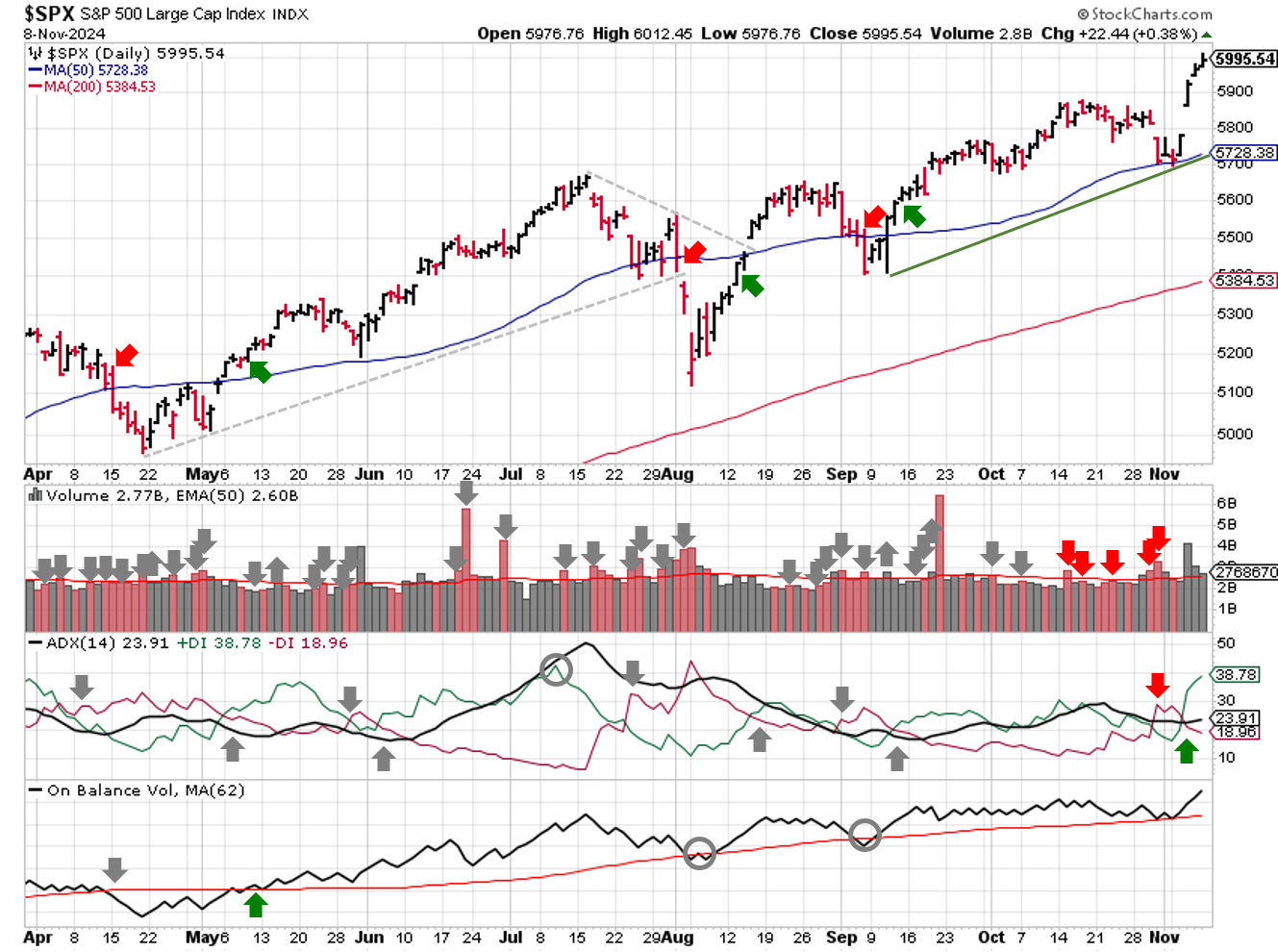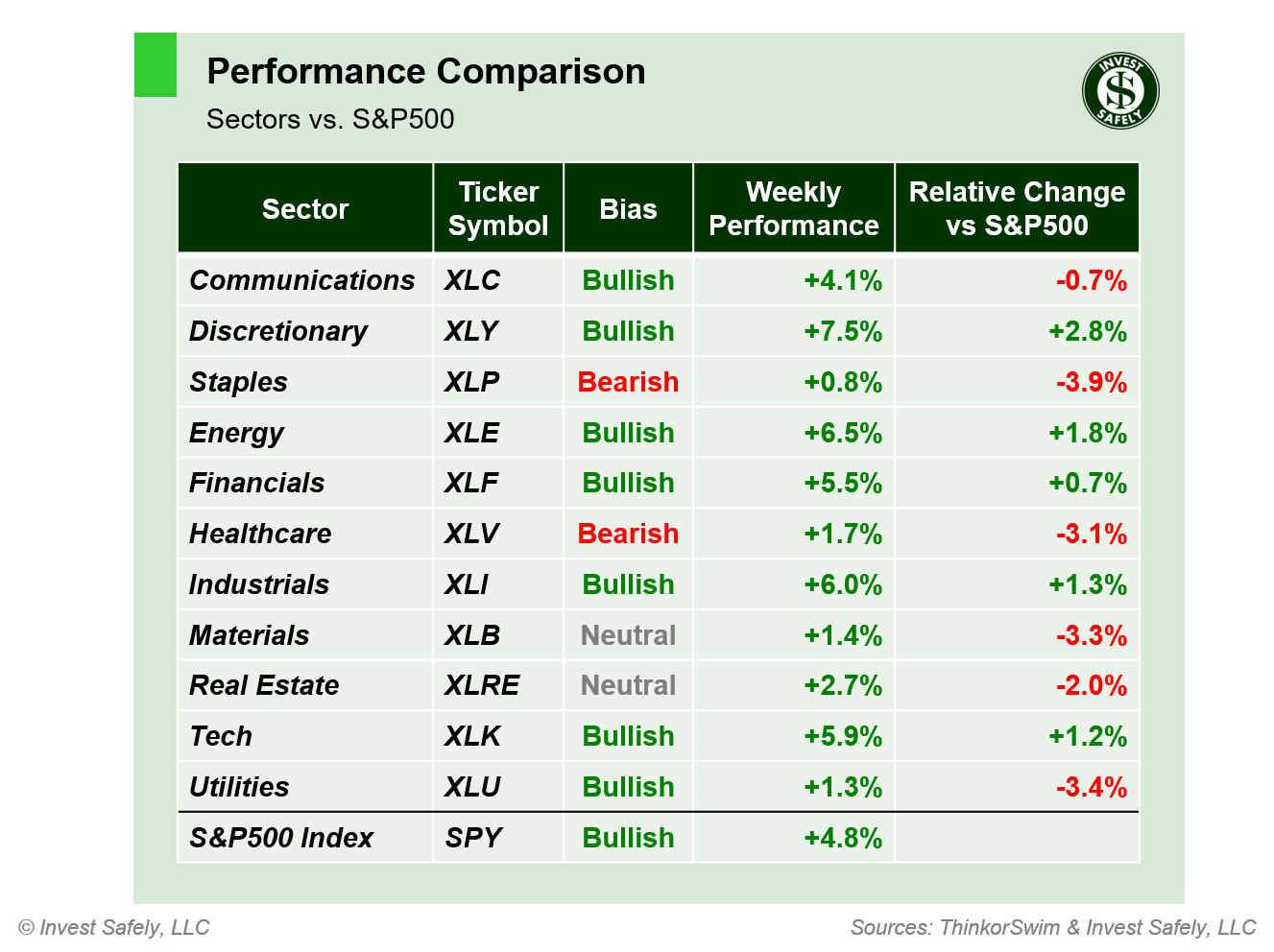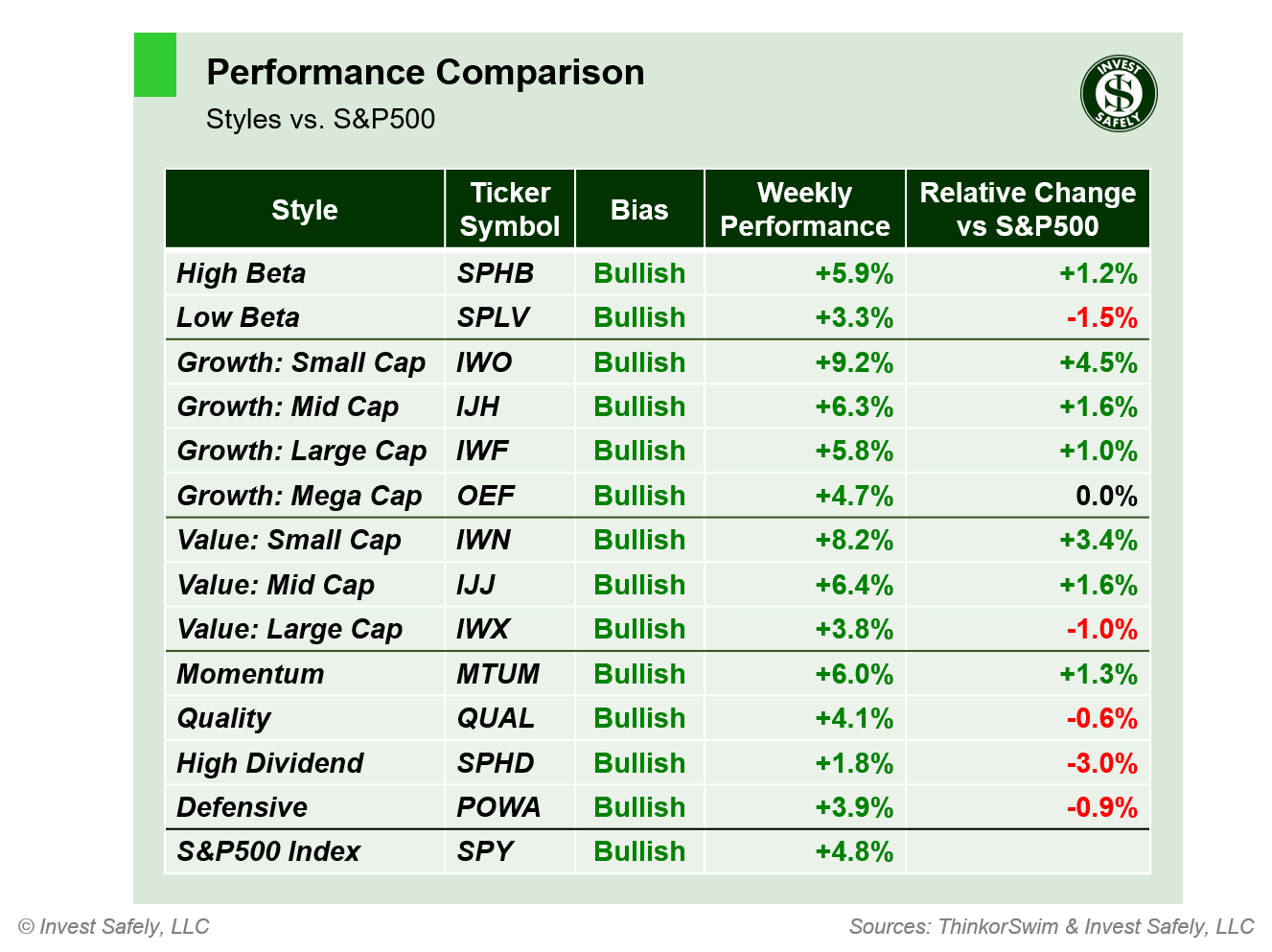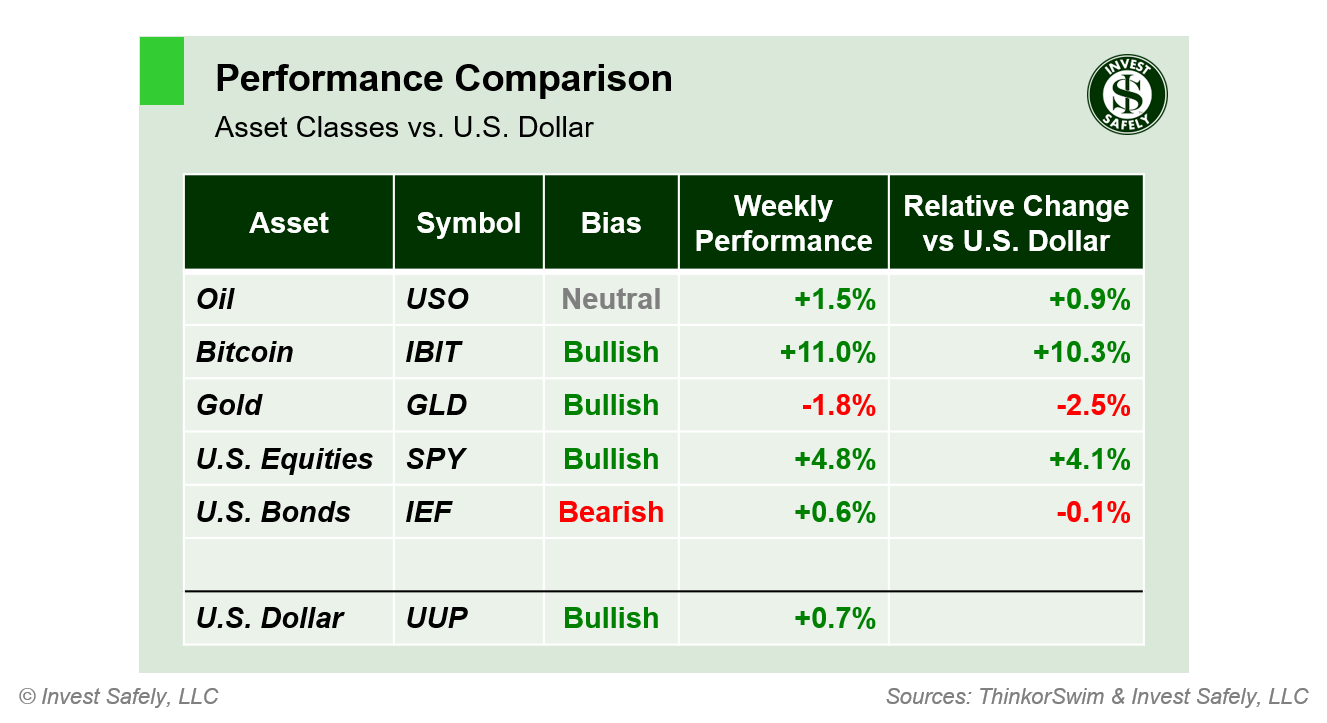Stock Market Outlook
For The Week Of November 10th =
Uptrend
INDICATORS
-
ADX Directional Indicators: Uptrend
On Balance Volume Indicator: Uptrend
Institutional Activity (Price & Volume): Uptrend
ANALYSIS
The stock market outlook remains in an uptrend, after a bullish response to U.S. election results and another rate cut by the FOMC.
The S&P500 ( $SPX ) rallied 4.7%. The index sits ~5% above the 50-day moving average and ~11% above the 200-day moving average.
SPX Technical Analysis - November 10 2024
All three signals are back to an uptrend. The ADX ( Average Directional Index ) and Institutional Activity rejoined OBV ( On-Balance Volume ) in bullish territory.
Utilities ( $XLU ) shifted back to bullish from neutral and Real Estate ( $XLRE ) switched from bearish to neutral. The energy sector ( $XLE ) was the biggest mover, jumping from bearish to bullish bias with a 6.5% gain. Industrials ( $XLI ) also outperformed with a gain of 6%. The worst sector was Consumer Staples ( $XLP ) with a gain of less than 1%.
Low Beta, Small Cap Value, Quality and High Dividend sector styles moved back to a bullish bias last week. Small Cap Growth ( $IWO ) led the way higher (same as the week prior), while High Dividend ( $SPHD ) underperformed the general index by 3%.
Bitcoin ( $IBIT ) was the best asset class, rallying another 11%, while gold ( $GLD ) fell nearly 2%. Oil ( $USO ) shifted from bearish to neutral bias as well.
COMMENTARY
Election-related volatility stole the show last week, with most risk assets responding with strong upside moves to expected policy shifts. That said, most asset classes, equity sectors, and investing styles are now overbought.
In other macro news, Services PMI was expansionary and higher than expected, hitting levels last seen in 2022. Adding more juice to the economy, the FOMC cut rates another 25 bps, citing strong economic data and tame inflation levels. However, they still feel their policy is restrictive, and plan to continue the current rate cutting cycle, albeit at a "slower" pace.
Behind the scenes, the Federal Reserves balance sheet run-off (i.e. QT) continues, with assets down to roughly the April 2020 level, or the balance after the first wave of Covid-19 quantitative easing. There are some rumblings about financial sector liquidity, because the reverse repo facility is below $200b for the first time since 2021.
During the coming week, we'll get another set of inflation data (October CPI/PPI), along with more earnings reports.
Best to Your Week!
P.S. If you find this research helpful, please tell a friend.
If you don't, tell an enemy.
Sources: Bloomberg, CNBC, Federal Reserve Bank of St. Louis, Hedgeye, U.S. Bureau of Economic Analysis, U.S. Bureau of Labor Statistics
Share this Post on:

How to Make Money in Stocks: A Winning System in Good Times and Bad.
It's one of my favorites.
I regularly share articles and other news of interest on:
Twitter (@investsafely)
Facebook (@InvestSafely)
LinkedIn (@Invest-Safely)
Instagram (@investsafely)
Invest Safely, LLC is an independent investment research and online financial media company. Use of Invest Safely, LLC and any other products available through invest-safely.com is subject to our Terms of Service and Privacy Policy. Not a recommendation to buy or sell any security.
Charts provided courtesy of stockcharts.com.
For historical Elliott Wave commentary and analysis, go to ELLIOTT WAVE lives on by Tony Caldaro. Current counts can be found at: Pretzel Logic, and 12345ABCDEWXYZ
Once a year, I review the market outlook signals as if they were a mechanical trading system, while pointing out issues and making adjustments. The goal is to give you to give you an example of how to analyze and continuously improve your own systems.
- 2015 Performance - Stock Market Outlook
- 2016 Performance - Stock Market Outlook
- 2017 Performance - Stock Market Outlook
- 2018 Performance - Stock Market Outlook
- 2019 Performance - Stock Market Outlook
- 2020 Performance - Stock Market Outlook
IMPORTANT DISCLOSURE INFORMATION
This material is for general communication and is provided for informational and/or educational purposes only. None of the content should be viewed as a suggestion that you take or refrain from taking any action nor as a recommendation for any specific investment product, strategy, or other such purpose. Certain information contained herein has been obtained from third-party sources believed to be reliable, but we cannot guarantee its accuracy or completeness.
To the extent that a reader has any questions regarding the applicability of any specific issue discussed above to his/her individual situation, he/she is encouraged to consult with the professional advisors of his/her choosing. Invest Safely, LLC is not a law firm, certified public accounting firm, or registered investment advisor and no portion of its content should be construed as legal, accounting, or investment advice.
The material is not to be construed as an offer or a recommendation to buy or sell a security nor is it to be construed as investment advice. Additionally, the material accessible through this website does not constitute a representation that the investments described herein are suitable or appropriate for any person.
Hypothetical Presentations:
Any referenced performance is “as calculated” using the referenced funds and has not been independently verified. This presentation does not discuss, directly or indirectly, the amount of the profits or losses, realized or unrealized, by any reader or contributor, from any specific funds or securities.
The author and/or any reader may have experienced materially different performance based upon various factors during the corresponding time periods. To the extent that any portion of the content reflects hypothetical results that were achieved by means of the retroactive application of a back-tested model, such results have inherent limitations, including:
Model results do not reflect the results of actual trading using assets, but were achieved by means of the retroactive application of the referenced models, certain aspects of which may have been designed with the benefit of hindsight
Back-tested performance may not reflect the impact that any material market or economic factors might have had on the use of a trading model if the model had been used during the period to actually manage assets
Actual investment results during the corresponding time periods may have been materially different from those portrayed in the model
Past performance may not be indicative of future results. Therefore, no one should assume that future performance will be profitable, or equal to any corresponding historical index.
The S&P 500 Composite Total Return Index (the "S&P") is a market capitalization-weighted index of 500 widely held stocks often used as a proxy for the stock market. Standard & Poor's chooses the member companies for the S&P based on market size, liquidity, and industry group representation. Included are the common stocks of industrial, financial, utility, and transportation companies. The S&P is not an index into which an investor can directly invest. The historical S&P performance results (and those of all other indices) are provided exclusively for comparison purposes only, so as to provide general comparative information to assist an individual in determining whether the performance of a specific portfolio or model meets, or continues to meet investment objective(s). The model and indices performance results do not reflect the impact of taxes.
Investing involves risk (even the “safe” kind)! Past performance does not guarantee or indicate future results. Different types of investments involve varying degrees of underlying risk. Therefore, do not assume that future performance of any specific investment or investment strategy be suitable for your portfolio or individual situation, will be profitable, equal any historical performance level(s), or prove successful (including the investments and/or investment strategies describe on this site).






